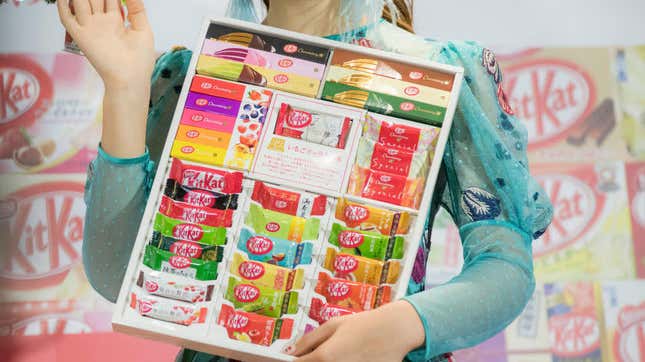
One of the strange things about consumerism is that sometimes things don’t sell for the reasons you anticipated they would. Case in point: Japanese Kit Kats.
Kit Kats were originally developed in England by the confectionary company Rowntree, which promoted them as a snack for the workingman. After World War II, Rowntree adopted the slogan “Have a break, have a Kit Kat” and began exporting Kit Kats overseas to former British colonies and, in the 1970s, Japan.
At first they did not go over well, writes Gillian Tett in Financial Times. Kit Kats were marketed as a British treat. The ads showed British people doing British things and using Kit Kats for energy, operating under the assumption that Japanese people yearned to travel, especially to the UK. But the Japanese weren’t buying it, even after Nestlé acquired Kit Kat in 1988 (except in the U.S., where Kit Kat is made by Hershey). By the turn of the millennium, Kit Kat sales were still languishing in Japan, even after an attempt to target students, and Nestlé wanted to know why.
It turns out that Japanese students were stressed out by their juken exams, which determine the course of the rest of their lives, and the only break they wanted was to sleep, not to eat chocolate.
But then two Nestlé regional managers, Masafumi Ishibashi and Kohzoh Takaoka, noticed something interesting: Kit Kat sales were surging on the southern island of Kyushu between December and February, juken season. It turned out that the students had realized that Kit Kat sounded a bit like the Japanese phrase kitto katsu, which means “you will overcome,” and were giving Kit Kat bars to their friends as a sign of encouragement.
Without telling their bosses in Switzerland, who demanded consistency in marketing across their international brands, Ishibashi and Takaoka began creating Japanese Kit Kat ads that said “Kitto sakura saku yo!”(literally “Cherry blossoms will bloom” but idiomatically “Wishes come true”) and giving away free Kit Kats to students.
“Sales of KitKats exploded among students across Japan,” Tett writes. “Teenagers redefined the bar as an omamori, the good-luck token sold at Shinto shrines and Buddhist temples. In January 2003, 34 per cent of Japanese teenagers told pollsters that a KitKat was their favourite good-luck charm, second only to an omamori blessed by a genuine Shinto priest. “It was amazing,” recalls Ishibashi. “[Chocolate] became an omamori.”
By 2003, Japan had completely embraced Kit Kats, Nestlé HQ had given its blessing to the change in marketing, and Kit Kat Japan began thinking of ways it could make the candy more Japanese. Executives hit on the idea of using Japanese flavors and the team created two new flavors especially for Japan: strawberry and matcha.
You know what happened next. Japan became known for having the best Kit Kat flavors. Tourists began carrying them back to Britain and other countries as souvenirs of Japan. And then Nestlé began selling matcha Kit Kats back in the UK! (They were manufactured in the plant in Germany, not Japan, but whatever.) Full circle! The moral of the story, according to Ryoji Maki, one of the executives who introduced the new flavors, is this: “You have to listen to consumers.”
Also, Kit Kats are good luck! Anyway, it’s a fascinating story, and you can read the whole thing here.